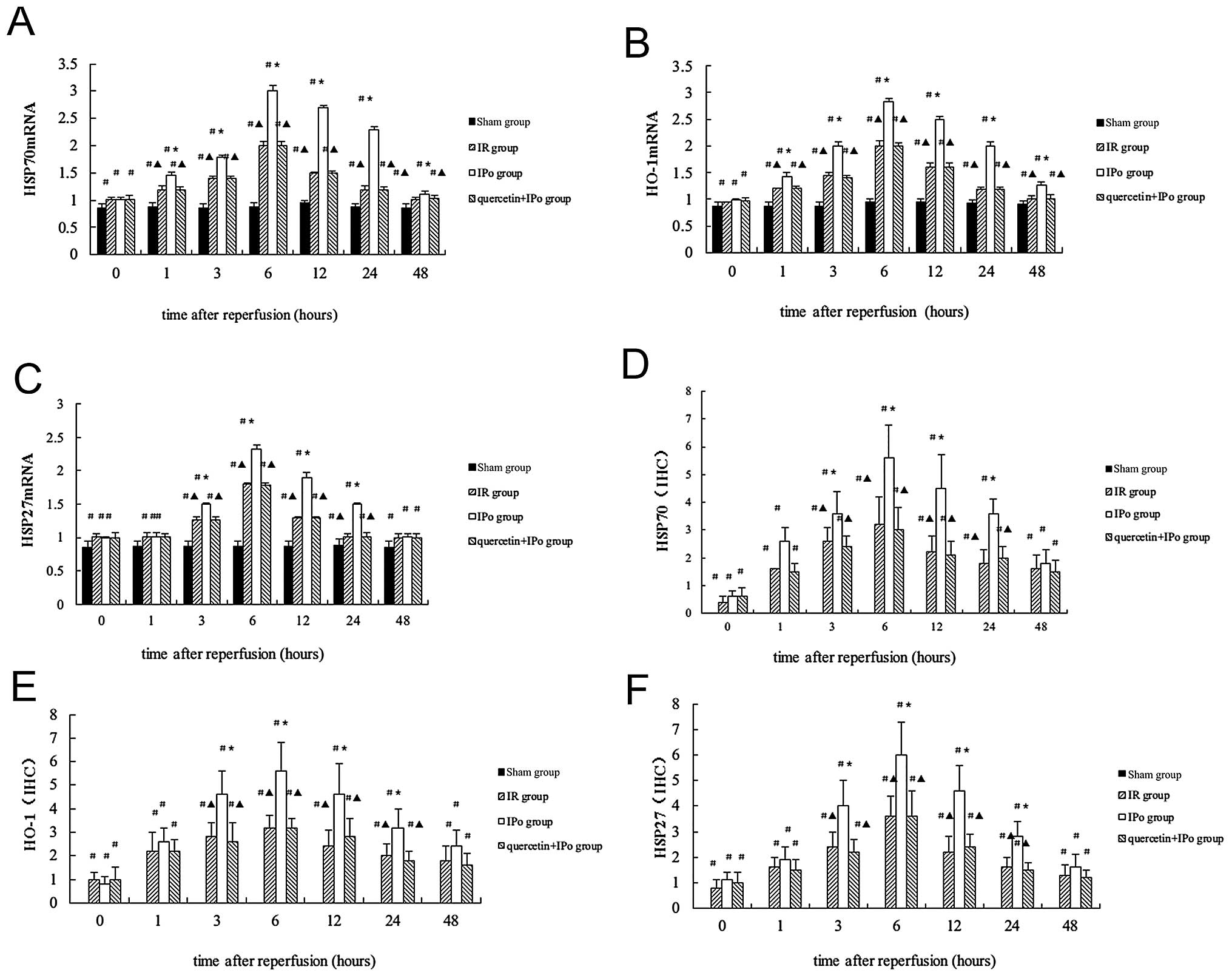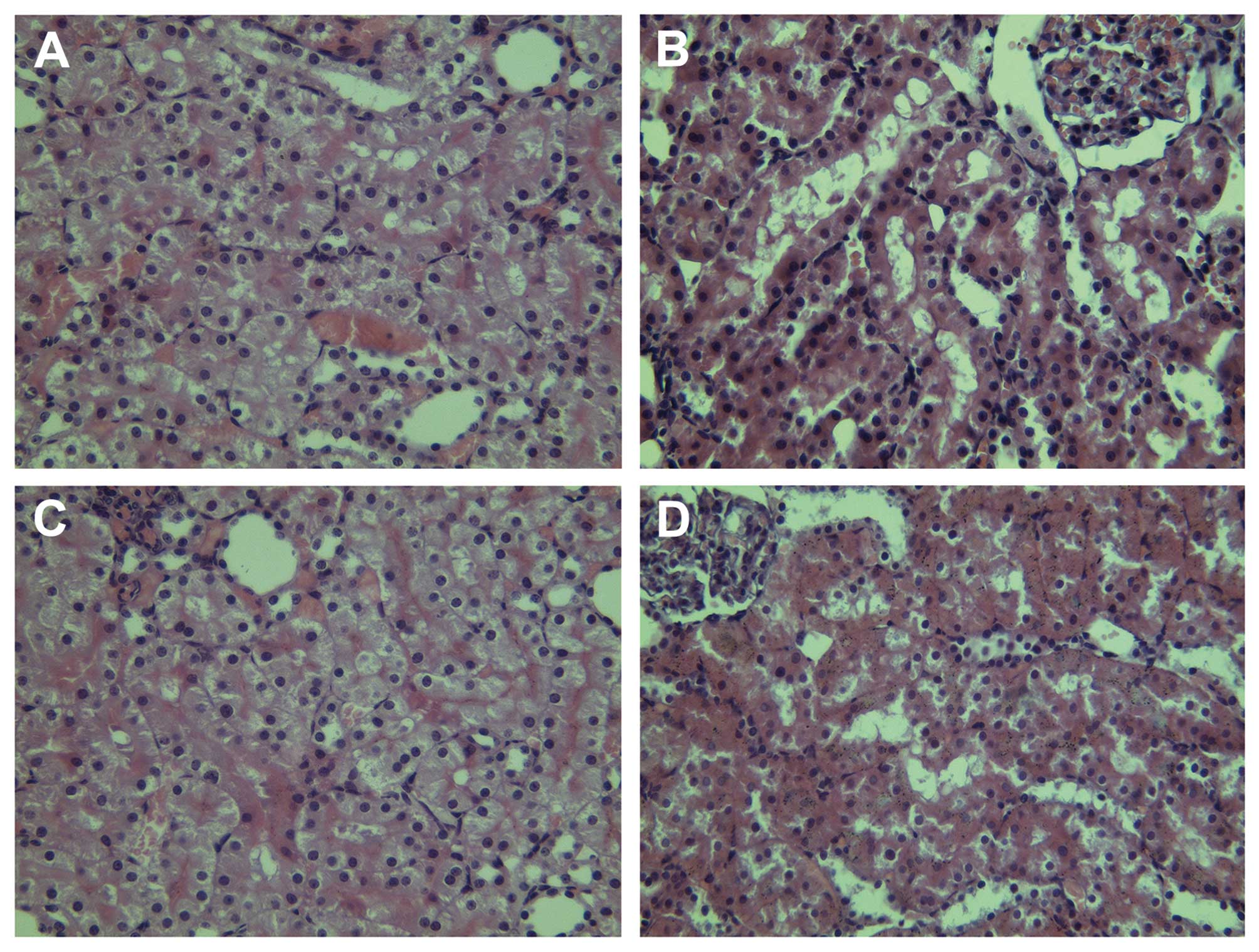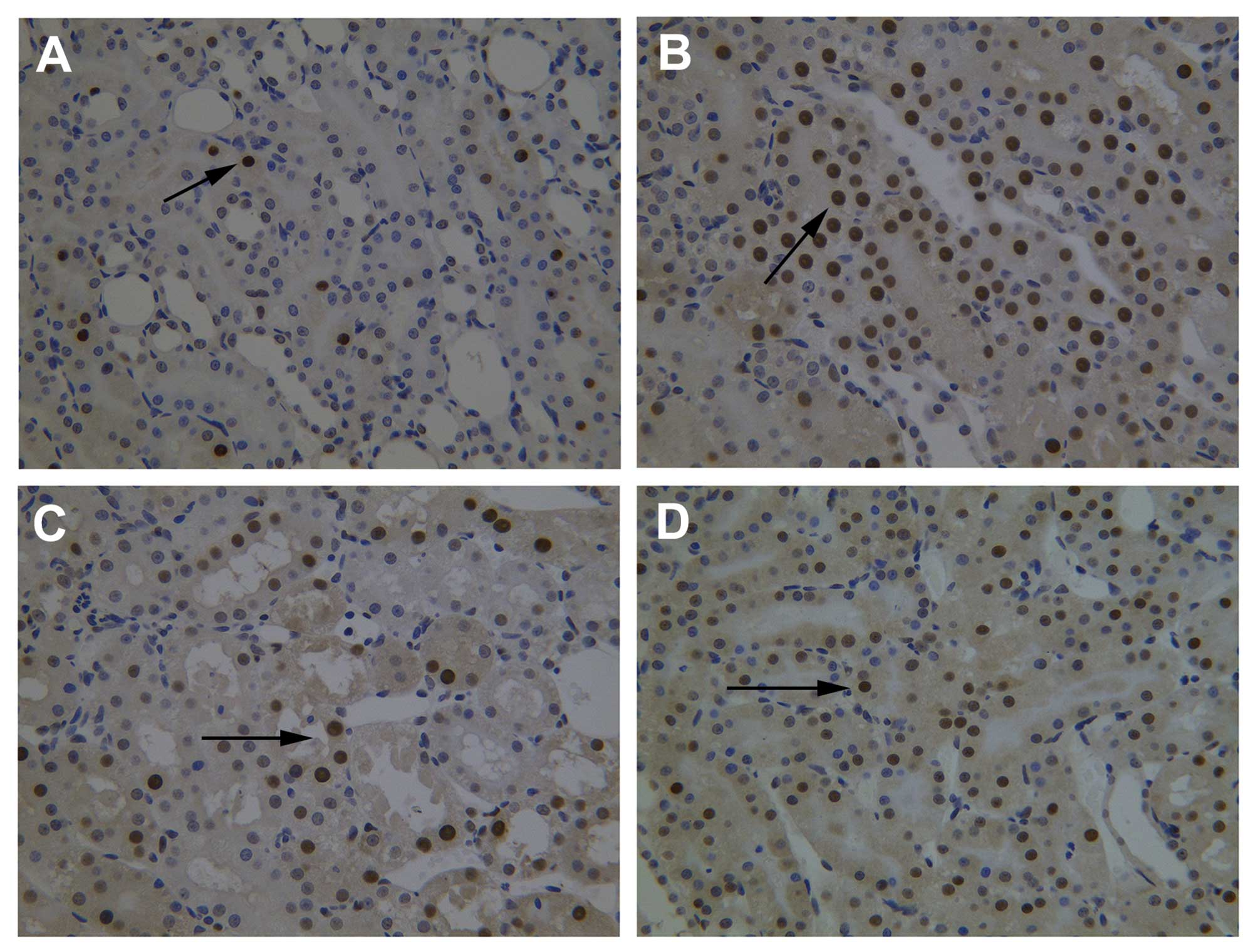|
1
|
Serviddio G, Romano AD, Gesualdo L, et al:
Postconditioning is an effective strategy to reduce renal
ischaemia/reperfusion injury. Nephrol Dial Transplant.
23:1504–1512. 2008. View Article : Google Scholar : PubMed/NCBI
|
|
2
|
Kunduzova OR, Bianchi P, Pizzinat N, et
al: Regulation of JNK/ERK activation, cell apoptosis, and tissue
regeneration by monoamine oxidases after renal
ischemia-reperfusion. FASEB J. 16:1129–1131. 2002.PubMed/NCBI
|
|
3
|
Akoh JA: Transplant nephrectomy. World J
Transplant. 1:4–12. 2011. View Article : Google Scholar
|
|
4
|
Zhao ZQ, Corvera JS, Halkos ME, et al:
Inhibition of myocardial injury by ischemic postconditioning during
reperfusion: comparison with ischemic preconditioning. Am J Physiol
Heart Circ Physiol. 285:H579–H588. 2003.PubMed/NCBI
|
|
5
|
Penna C, Tullio F, Moro F, et al: Effects
of a protocol of ischemic postconditioning and/or captopril in
hearts of normotensive and hypertensive rats. Basic Res Cardiol.
105:181–192. 2010. View Article : Google Scholar : PubMed/NCBI
|
|
6
|
Wever KE, Menting T, Masereeuw R, et al:
Local and remote ischemic postconditionings have synergistic
protective effects on renal ischemia-reperfusion injury.
Transplantation. 94:e1–e2. 2012. View Article : Google Scholar
|
|
7
|
Wang JY, Shen J, Gao Q, et al: Ischemic
postconditioning protects against global cerebral
ischemia/reperfusion-induced injury in rats. Stroke. 39:983–990.
2008. View Article : Google Scholar : PubMed/NCBI
|
|
8
|
Liu KX, Li YS, Huang WQ, et al: Immediate
postconditioning during reperfusion attenuates intestinal injury.
Intensive Care Med. 35:933–942. 2009. View Article : Google Scholar : PubMed/NCBI
|
|
9
|
Lønborg J, Kelbaek H, Vejlstrup N, et al:
Cardioprotective effects of ischemic postconditioning in patients
treated with primary percutaneous coronary intervention, evaluated
by magnetic resonance. Circ Cardiovasc Interv. 3:34–41. 2010.
|
|
10
|
Deftereos S, Giannopoulos G, Tzalamouras
V, et al: Renoprotective effect of remote ischemic
post-conditioning by intermittent balloon inflations in patients
undergoing percutaneous coronary intervention. J Am Coll Cardio.
61:1949–1955. 2013. View Article : Google Scholar
|
|
11
|
Liu JJ, Zhao YL and Zhang YD: Effects of
ischemic postconditioning on the renal ischemia-reperfusion injury
in rats. Chin J Anesthesiol. 27:651–654. 2007.
|
|
12
|
Miklós Z, Kürthy M, Degrell P, et al:
Ischaemic postconditioning reduces serum and tubular TNF-α
expression in ischaemic-reperfused kidney in healthy rats. Clin
Hemorheol Microcirc. 50:167–178. 2012.PubMed/NCBI
|
|
13
|
Heusch G, Büchert A, Feldhaus S and Schulz
R: No loss of cardioprotection by postconditioning in connexin
43-deficient mice. Basic Res Cardiol. 101:354–356. 2006. View Article : Google Scholar : PubMed/NCBI
|
|
14
|
Stricher F, Macri C, Ruff M and Muller S:
HSPA8/HSC70 chaperone protein: Structure, function, and chemical
targeting. Autophagy. 9:2013. View Article : Google Scholar : PubMed/NCBI
|
|
15
|
Ziemann E, Zembroñ-Lacny A, Kasperska A,
et al: Exercise training-induced changes in inflammatory mediators
and heat shock proteins in young tennis players. J Sports Sci Med.
12:282–289. 2013.
|
|
16
|
Morse D and Choi AM: Heme oxygenase-1: the
‘emerging molecule’ has arrived. Am J Respir Cell Mol Biol.
27:8–16. 2002.
|
|
17
|
Zhang PL, Lun M, Schworer CM, et al: Heat
shock protein expression is highly sensitive to
ischemia-reperfusion injury in rat kidneys. Ann Clin Lab Sci.
38:57–64. 2008.PubMed/NCBI
|
|
18
|
Xing B, Chen H, Zhang M, et al: Ischemic
postconditioning inhibits apoptosis after focal cerebral
ischemia/reperfusion injury in the rat. Stroke. 39:2362–2369. 2008.
View Article : Google Scholar : PubMed/NCBI
|
|
19
|
Xu B, Gao X, Xu J, et al: Ischemic
postconditioning attenuates lung reperfusion injury and reduces
systemic proinflammatory cytokine release via heme oxygenase 1. J
Surg Res. 166:e157–164. 2011. View Article : Google Scholar
|
|
20
|
Manwell LA and Heikkila JJ: Examination of
KNK437- and quercetin-mediated inhibition of heat shock-induced
heat shock protein gene expression in Xenopus laevis cultured
cells. Comp Biochem Physiol A Mol Integr Physiol. 148:521–530.
2007. View Article : Google Scholar
|
|
21
|
Khomenko IP, Bakhtina LY, Zelenina OM, et
al: Role of heat shock proteins HSP70 and HSP32 in the protective
effect of adaptation of cultured HT22 hippocampal cells to
oxidative stress. Bull Exp Biol Med. 144:174–177. 2007. View Article : Google Scholar : PubMed/NCBI
|
|
22
|
Yang CW, Li C, Jung JY, et al:
Preconditioning with erythropoietin protects against subsequent
ischemia-reperfusion injury in rat kidney. FASEB J. 17:1754–1755.
2003.PubMed/NCBI
|
|
23
|
Yao K, Rao H, Wu R, Tang X and Xu W:
Expression of Hsp70 and Hsp27 in lens epithelial cells in contused
eye of rat modulated by thermotolerance or quercetin. Mol Vis.
12:445–450. 2006.
|
|
24
|
Lepore DA, Knight KR, Anderson RL and
Morrison WA: Role of priming stresses and Hsp70 in protection from
ischemia-reperfusion injury in cardiac and skeletal muscle. Cell
Stress Chaperones. 6:93–96. 2001. View Article : Google Scholar : PubMed/NCBI
|
|
25
|
Siu PM, Wang Y and Alway SE: Apoptotic
signaling induced by H2O2-mediated oxidative stress in
differentiated C2C12 myotubes. Life Sci. 84:468–481. 2009.
View Article : Google Scholar : PubMed/NCBI
|
|
26
|
Bidmon B, Endemann M, Müller T, et al:
Heat shock protein-70 repairs proximal tubule structure after renal
ischemia. Kidney Int. 58:2400–2407. 2000. View Article : Google Scholar : PubMed/NCBI
|
|
27
|
Guo S, Wharton W, Moseley P and Shi H:
Heat shock protein 70 regulates cellular redox status by modulating
glutathione-related enzyme activities. Cell Stress Chaperones.
12:245–254. 2007. View Article : Google Scholar : PubMed/NCBI
|
|
28
|
Katavetin P, Inagi R, Miyata T, et al:
Erythropoietin induces heme oxygenase-1 expression and attenuates
oxidative stress. Biochem Biophys Res Commun. 359:928–934. 2007.
View Article : Google Scholar : PubMed/NCBI
|
|
29
|
Ferenbach DA, Ramdas V, Spencer N, et al:
Macrophages expressing heme oxygenase-1 improve renal function in
ischemia/reperfusion injury. Mol Ther. 18:1706–1713. 2010.
View Article : Google Scholar : PubMed/NCBI
|
|
30
|
Park J, Kang JW and Lee SM: Activation of
the cholinergic anti-inflammatory pathway by nicotine attenuates
hepatic ischemia/reperfusion injury via heme oxygenase-1 induction.
Eur J Pharmacol. 707:61–70. 2013. View Article : Google Scholar : PubMed/NCBI
|
|
31
|
Saeki I, Matsuura T, Hayashida M and
Taguchi T: Ischemic preconditioning and remote ischemic
preconditioning have protective effect against cold
ischemia-reperfusion injury of rat small intestine. Pediatr Surg
Int. 27:857–862. 2011. View Article : Google Scholar
|
|
32
|
Jia XM, Zhou ZX, Huang JJ, Chu W and Guan
QH: Protective effects of the induction of heme oxygenase-1 on
ischemia reperfusion lung injury: in vivo experiment with
rats. Zhonghua Yi Xue Za Zhi. 87:1211–1213. 2007.(In Chinese).
|
|
33
|
Park SW, Chen SW, Kim M, D’Agati VD and
Lee HT: Human heat shock protein 27-overexpressing mice are
protected against acute kidney injury after hepatic ischemia and
reperfusion. Am J Physiol Renal Physiol. 297:F885–F894. 2009.
View Article : Google Scholar : PubMed/NCBI
|
|
34
|
Chen SW, Park SW, Kim M, et al: Human heat
shock protein 27 overexpressing mice are protected against hepatic
ischemia and reperfusion injury. Transplantation. 87:1478–1487.
2009. View Article : Google Scholar
|
|
35
|
Park SW, Chen SW, Kim M, D’Agati VD and
Lee HT: Selective intrarenal human A1 adenosine receptor
overexpression reduces acute liver and kidney injury after hepatic
ischemia reperfusion in mice. Lab Invest. 90:476–495. 2010.
View Article : Google Scholar
|
|
36
|
Chen SW, Kim M, Kim M, et al: Mice that
overexpress human heat shock protein 27 have increased renal injury
following ischemia reperfusion. Kidney Int. 75:499–510. 2009.
View Article : Google Scholar
|
|
37
|
Kuboki S, Schuster R, Blanchard J, et al:
Role of heat shock protein 70 in hepatic ischemia-reperfusion
injury in mice. Am J Physiol Gastrointest Liver Physiol.
292:G1141–G1149. 2007. View Article : Google Scholar : PubMed/NCBI
|
|
38
|
Devey L, Mohr E, Bellamy C, et al: c-Jun
terminal kinase-2 gene deleted mice overexpress hemeoxygenase-1 and
are protected from hepatic ischemia reperfusion injury.
Transplantation. 88:308–316. 2009. View Article : Google Scholar : PubMed/NCBI
|
|
39
|
Ke B, Shen XD, Gao F, et al: Small
interfering RNA targeting heme oxygenase-1 (HO-1) reinforces liver
apoptosis induced by ischemia-reperfusion injury in mice: HO-1 is
necessary for cytoprotection. Hum Gene Ther. 20:1133–1142. 2009.
View Article : Google Scholar : PubMed/NCBI
|
|
40
|
Manucha W and Vallés PG: Cytoprotective
role of nitric oxide associated with Hsp70 expression in neonatal
obstructive nephropathy. Nitric Oxide. 18:204–215. 2008. View Article : Google Scholar : PubMed/NCBI
|
















